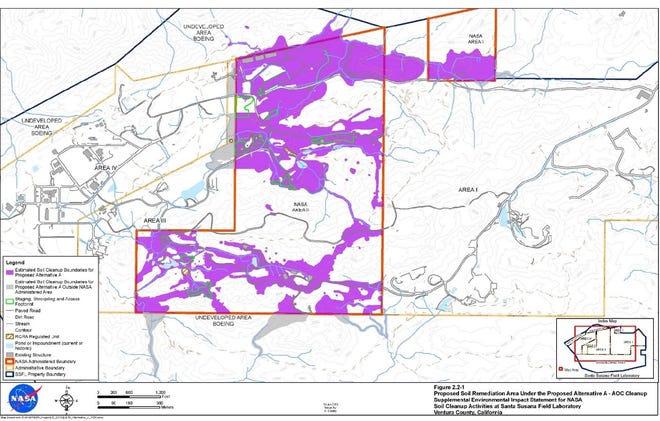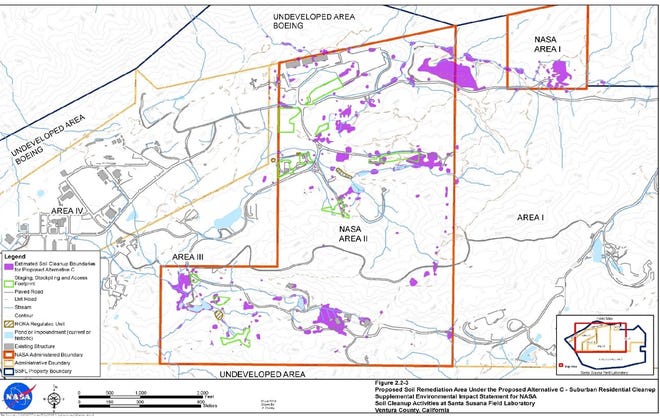“NASA’s absurd excuse for cleaning up so much less contamination than it promised is that it has discovered there is much more contamination at the site than it had previously realized,” — cleanup activist Dan Hirsch, president of the Committee to Bridge the Gap
BY: Mike Harris | Ventura County Star vcstar.com
NASA has decided to clean up contaminated soil at its portion of the Santa Susana Field Laboratory site to a less stringent standard than it agreed to in a 2010 legally binding agreement with the state.
The federal agency announced its decision last week, outraging cleanup activists and some local officials.
The activists say NASA’s planned cleanup, outlined in a formal Record of Decision, would leave 84% of its contaminated acres not remediated at the site outside Simi Valley.
That would violate a 2010 legally binding agreement — formally called an Administrative Order on Consent — NASA signed with the California Department of Toxic Substances Control to clean up its acres “to background,” the most exacting standard.
That means NASA would remediate the acres to the condition they were in before the contamination occurred.
Instead, NASA has decided to remediate the acres to the less stringent “suburban residential cleanup standard.”
“NASA’s absurd excuse for cleaning up so much less contamination than it promised is that it has discovered there is much more contamination at the site than it had previously realized,” said cleanup activist Dan Hirsch, president of the Committee to Bridge the Gap, a nonprofit nuclear policy organization, and the retired director of the Program on Environmental and Nuclear Policy at UC Santa Cruz.
But NASA spokeswoman Shannon Segovia said that in 2013 — three years after NASA entered into the cleanup agreement — the toxic substances control department established cleanup standards for the field lab site that are more severe than for any other cleanup led by the state agency and which NASA cannot meet.
She said the challenge NASA faces with the 2010 agreed upon remediation “is that technical analysis indicates that a cleanup to these … values is not feasible,” she said.


The less stringent cleanup standard NASA is planning “would be protective of public health and the environment and is consistent with … standards applied by DTSC throughout the state,” Segovia said.
She said it would remove about 90% as much of the soil contamination as cleanup by Administrative Order on Consent while requiring 70% less soil to be excavated and transported offsite.
The 2,850-acre site in unincorporated hills just southeast of Simi Valley at the Los Angeles County border experienced a partial nuclear meltdown in 1959 when it was the Rocketdyne/Atomics International rocket engine test and nuclear facility. The site also experienced other chemical and radioactive contamination over the years.
It is now largely owned by aerospace giant Boeing.
Russ Edmondson, spokesman for the toxic substances control department, said Tuesday the department “will not allow implementation of any NASA cleanup alternative that is inconsistent with the 2010 AOC document.”
In a letter to NASA officials, the department says it “will hold NASA accountable for meeting NASA’s legal requirements under the 2010 Administrative Order on Consent.”
That could include litigation, said Hirsch.
But Segovia said, “NASA looks forward to working with the DTSC to resolve outstanding cleanup issues and to achieve our shared goal of implementing a science-based cleanup at SSFL that protects public health and preserves the site’s natural, historic, and Native American cultural resources.”
Simi Valley City Councilwoman Ruth Luevanos said she was “angered and disappointed that NASA has chosen to betray the memories of all those who have already died of cancers by breaking their legally binding agreement yet again.”
Activists allege that the site’s contamination has led to numerous people who live nearby contracting cancer.
Ventura County Supervisor Linda Parks said NASA’s decision is “unacceptable.”
“NASA has reneged on their signed agreement to clean up all of their highly toxic contamination. Until they do, the health of the public will continue to be threatened,” she said.
NASA’s decision is independent of its proposal to have the entire site designated a Native American cultural district, which cleanup activists say is a ploy to undermine the remediation of all 2,850 acres, not just NASA’s acres.
They note that the 2010 cleanup agreement contains exemptions for land containing Native American artifacts.
Local Native American groups say the site is sacred to them.
NASA’s proposal is being considered by the National Park Service for a final determination as to whether the entire field lab site is eligible to be listed in the National Register of Historic Places.
The site is divided into four areas with northern and southern buffer zones. NASA is responsible for remediating Area 2 and its part of Area 1
Boeing is responsible for cleaning up Area 3, its part of Area 1 and the Southern Buffer Zone. The U.S. Department of Energy is responsible for cleaning up Area 4 and the Northern Buffer Zone.
Under the 2010 agreement, the long-delayed cleanup was supposed to have been completed by the end of 2017. But it hasn’t begun yet.
Mike Harris covers the East County cities of Simi Valley and Thousand Oaks, as well as transportation countywide. You can contact him at mike.harris@vcstar.com or 805-437-0323.
